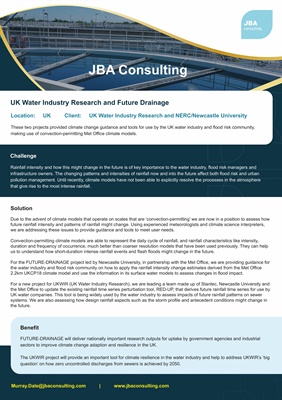
JBA Consulting
Rainfall intensity and how this might change in the future is of key importance to the water industry, flood risk managers and
infrastructure owners. The changing patterns and intensities of rainfall now and into the future affect both flood risk and urban
pollution management. Until recently, climate models have not been able to explicitly resolve the processes in the atmosphere
that give rise to the most intense rainfall.
Challenge
These two projects provided climate change guidance and tools for use by the UK water industry and flood risk community,
making use of convection-permitting Met Office climate models.
UK Water Industry Research and Future Drainage
Location: UK Client: UK Water Industry Research and NERC/Newcastle University
Solution
Due to the advent of climate models that operate on scales that are 'convection-permitting' we are now in a position to assess how
future rainfall intensity and patterns of rainfall might change. Using experienced meteorologists and climate science interpreters,
we are addressing these issues to provide guidance and tools to meet user needs.
Convection-permitting climate models are able to represent the daily cycle of rainfall, and rainfall characteristics like intensity,
duration and frequency of occurrence, much better than coarser resolution models that have been used previously. They can help
us to understand how short-duration intense rainfall events and flash floods might change in the future.
For the FUTURE-DRAINAGE project led by Newcastle University, in partnership with the Met Office, we are providing guidance for
the water industry and flood risk community on how to apply the rainfall intensity change estimates derived from the Met Office
2.2km UKCP18 climate model and use the information in its surface water models to assess changes in flood impact.
For a new project for UKWIR (UK Water Industry Research), we are leading a team made up of Stantec, Newcastle University and
the Met Office to update the existing rainfall time series perturbation tool, RED-UP, that derives future rainfall time series for use by
UK water companies. This tool is being widely used by the water industry to assess impacts of future rainfall patterns on sewer
systems. We are also assessing how design rainfall aspects such as the storm profile and antecedent conditions might change in
the future.
murray.dale@jbaconsulting.com | www.jbaconsulting.com
Benefit
FUTURE-DRAINAGE will deliver nationally important research outputs for uptake by government agencies and industrial
sectors to improve climate change adaption and resilience in the UK.
The UKWIR project will provide an important tool for climate resilience in the water industry and help to address UKWIR's 'big
question' on how zero uncontrolled discharges from sewers is achieved by 2050.